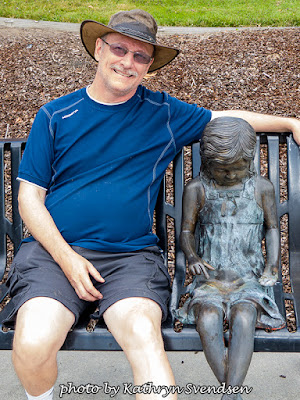 |
| I shot this photo of the Pitt River from the bridge on my walk this morning. |
It started with a system error display on my information console in my jeep. "Service electronic braking system" was flashed in front of me, between my "10 and 2" grips on the steering wheel. Something was amuck. Given the fact I just had a remote braking system installed that would allow me to flat tow my jeep legally behind my motorhome, I wasn't too surprised. It had been a six-hour job, by the book, for them to install the hardware, but it was double that in reality. Yesterday I made an appointment for them to look at what was causing the problem; I was to arrive there at 8:30.
I needed a plan to get there, drop my jeep off, and get home. There were lots of options. Wait for my daughter to pick me up at 11:00. Take a cab. Flat tow it there with the RV and then drive my rig, sans car, home again. Or, there was the healthy option - ride my bike. Riding my bicycle held the most appeal as it meant spending less money and not relying on anyone, plus there was the cardio benefit. The problem was I hadn't ridden it in two years and it had been stored in a semi-sheltered area.
Time and lack of maintenance have a way of degrading mechanical things. I found the bike was covered in spider webs, stem to stern as it were, and top to bottom to boot. Apparently, spiders really like the convenient distances between spokes, frame supports, chains, and cables. So, at 7:00 in the morning I dragged out my powerwasher and gave the whole thing a good hosing down. Once the cobwebs, dust, and other accumulated debris were removed it actually looked rideable.
As I moved the bike around I found the chain seem somewhat kinked. I raised the back end and rotated the pedals; the noise and jerky movement of the gears, changer, and chain left me quite unsure of its rideability. I got some oil out and greased the various components; no difference. Then I noticed the flat tires. Time to fire up the air compressor.
The air was completely spent in the tubes and they needed refilling. The tires were rated for 65 psi, and it would only take a few seconds to fill them. I hooked everything up and pressed the delivery mechanism on the hose. The gage read the gradual increase in pressure - 10, 20, 30, 40, 50, 60 psi. All very normal. However, at that moment there was a tremendous BANG and the whole thing deflated. OK; someone is trying to tell me something. Clearly, this is not going to work.
It was now 7:45 and I had to go. Fine; after dropping the car off I will walk to Pitt Meadows, buy a new bike there (given the horrible condition this one was in) and ride the rest of the way home. So I was off, and I expected to arrive early at my destination assuming normal traffic. The problem was that the day had been anything but normal, and the traffic fell right in line with that trend. The news announced severe congestion on the bridge and it wasn't long before I experienced it for myself. It was just as well because I ended up being there right on time. Something had gone right for a change.
The fellow I was scheduled to meet was stuck in that same traffic I had previously experienced, and he was nowhere to be found. Twenty minutes later he showed up, apologizing for his tardiness due to poor traffic. We traded salutations and I handed him over my keys. Before leaving I liberally applied sunscreen to myself because it was to be a scorcher and then retrieved my camera and bike helmet. I was off.
It was 9:00 by now and the bicycle shop would be open at 10. It was seven kilometers to my destination. I actually had a very enjoyable stroll, taking several photos along the way. My fatigue level was modest when I got to Harris road and the McDonald's there promised a reprieve from my journey. A large glass of ice water, an ice cream cone, and McMuffin revived me. I arrived at the bike shop sometime later. They were understaffed so it took a while before getting to talk to someone.
I bought a modest bicycle, made by Giant, a Canadian company, and, after strapping my helmet on, continued the trip home. I have not ridden a bicycle in two years and my body rejected the idea. Being determined to overcome my general lack of fitness, I pushed on. There were only twelve kilometers to go, not very far when traveling by bike, especially given the relatively flat terrain. The bike comes equipped with 24 gear combinations and I could only manage the lowest four. I was in sad shape indeed.
I arrived home at a little past 12:00. It had been a five hour ordeal. It all ended fairly well, I am still a little shaky though, three hours after the conclusion of my journey. I phoned the place that was servicing my car; it seems they nicked a line somewhere and needed to replace some parts. Thankfully they would take care of it. My car will be ready to pick up tomorrow. Now, how do I get there?





